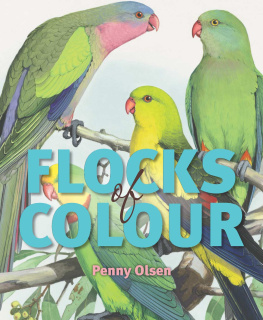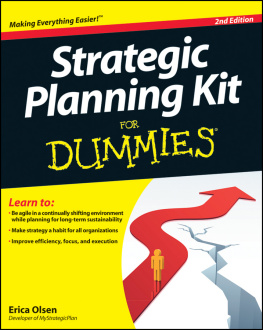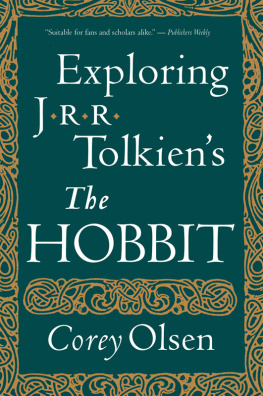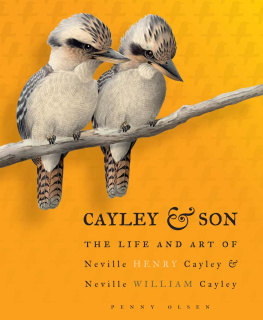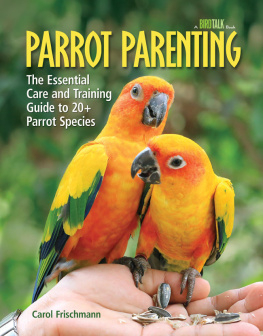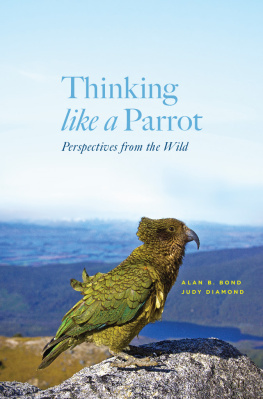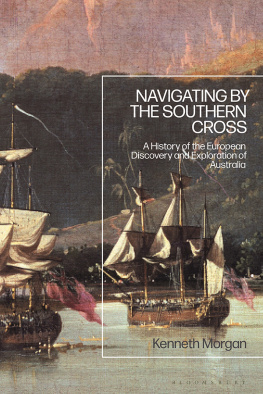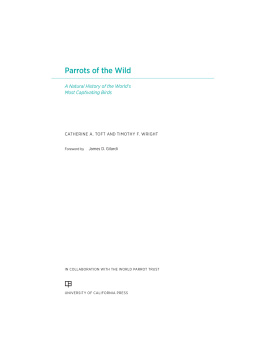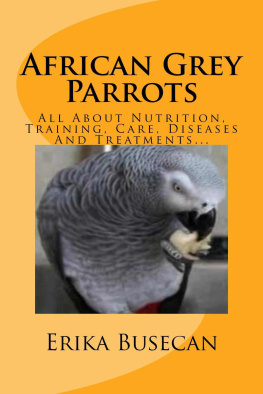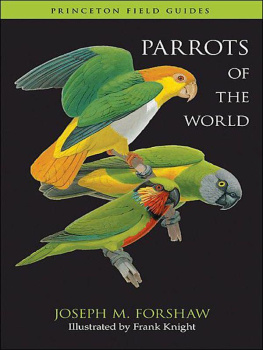William T. Cooper, Three Species of Parrot (Psephotus) 1970
There are five species in the genus Psephotus , which, like the rosellas, are found only in Australia. Pictured are the three Psephotus that nest in termite mounds: adult males of the Hooded Parrot (top left) and the Golden-shouldered Parrot (top right), and between them a generic female; below them perch an adult female and an adult male Paradise Parrot (bottom).
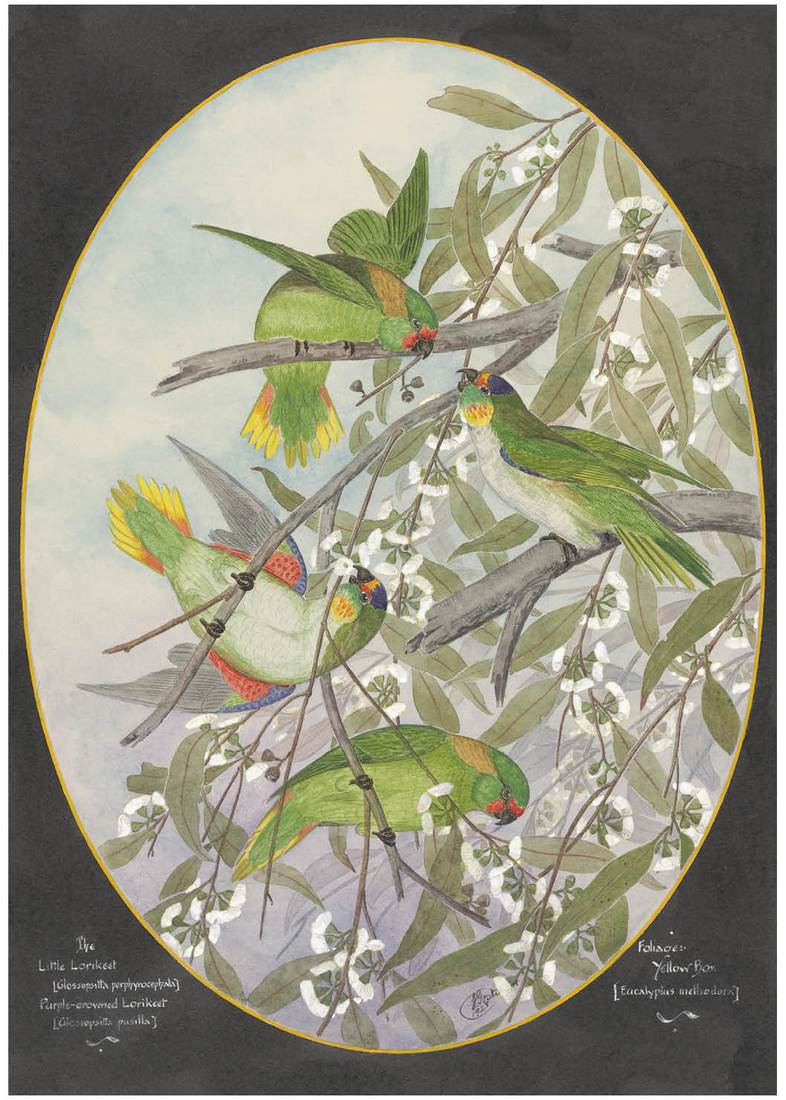
Ebenezer Edward Gostelow, The Little Lorikeet (Glossopsitta pusilla); Purple-crowned Lorikeet (Glossopsitta porphyrocephala) 1928
Lorikeets are nectar-feeders, flocking to trees that are blossoming. They are distributed across the warmer, wetter parts of Australia, where they can always find something blooming.
The archetypal parrot is a brilliantly coloured tropical species, and the tropics worldwide do indeed support the most species. But in Australia, parrots are found from the desert to the rainforest, from alpine habitats to lowlands, on the mainland and on islands far offshore, and from the dry tropics southwards to the subantarctic. Nor are all gaudily plumaged, indeed even the whitest and brightest are hued to blend with their environment: hidden amongst bright blossoms or all but invisible against the silvered glare of the sky.
The 14 cockatoos, which include the Galah and the Cockatiel, are a group of large, relatively plainly coloured species with mobile crests and powerful bills. Australia is their stronghold and just a few cockatoos occur on the islands to Australias north as far as the Philippines. The remaining 42 species, usually referred to as the parrotswhich includes lorikeets, fig-parrots, rosellas and the budgerigarare smaller and multi-hued. The unusual Norfolk Island Kaka may belong with this latter group, which has representatives spread (mainly) across the Southern Hemisphere.
Although they are a diverse group, suited to many environments, all parrots have a strong, broadish, down-curved bill, topped by a fleshy cere (the skin at the base of the upper beak), in which the nostrils are located. Most have short, sturdy legs and all have two toes forward and two back, for climbing, grasping, perching and, for some, holding food. The two ground-dwelling species, the Ground Parrot and the Night Parrot, have longer legs and flatter feet and claws.
Australias smallest parrot is the Budgerigar, weighing just 20 grams and with a total length of 18 centimetres, most of which is tail. At a diminutive 14 to 15 centimetres, the Little Lorikeet and Fig-Parrot are shorter but they have short tails and stocky bodies so that they weigh considerably more, between 35 and 40 grams. At the other end of the scale are the powerful Red-tailed Black-Cockatoo and Yellow-tailed Black-Cockatoo, weighing as much as 900 grams and with a length of 60 centimetres.
All the Australian parrots have features that accentuate their face, whether a flamboyant crest or a conspicuously coloured or patterned bill, eyes, cheeks or forehead. The sexes are often similar but the female is slightly smaller. When they do differ, generally the male is more boldly coloured or has a brighter eye or eye-skin and/or bill, and the immature birds most resemble the female. An exception, at least to the human eye, is the Eclectus Parrot in which the females are red and blue while the males are largely green, although the male has a bright orange bill whereas the females is black.
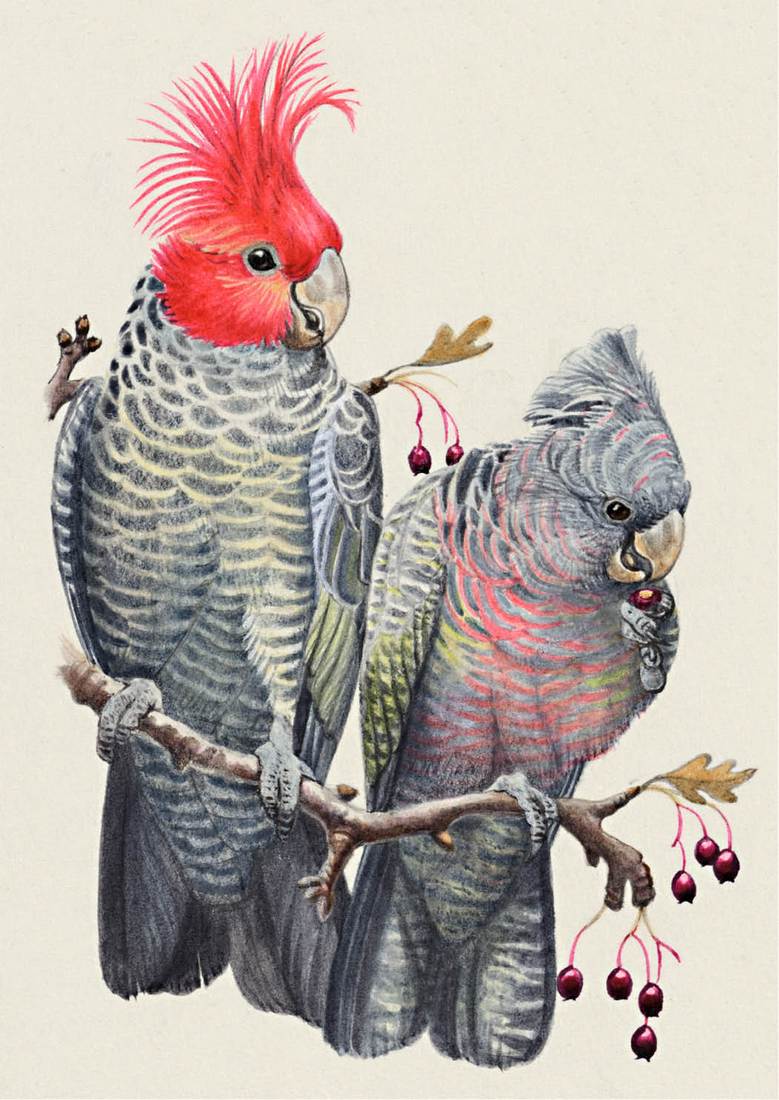
Betty Temple Watts, Gang-gang Cockatoo 1958 (adult male, left; adult female, right)
Not all parrots use a foot to hold food but when they do they prefer one hand over the other; in the case of the Gang-gang Cockatoo, it is nearly always the left foot. This is an outward manifestation of lateralisation of the brain, in which one side dominates in the performance of certain functions, as in humans.
Parrots can often be seen and even approached when feeding, whether scouring the ground for grains or corms, stripping grass seed from a delicate blade, gorging in blossom-laden bushes or chewing doggedly on foot-held, seemingly impenetrable nuts. The cockatoos are equipped to eat tougher, larger food items than the other parrots. They eat seeds, nuts, berries, fruits, blossoms, corms and roots, palm shoots and invertebrates, especially wood-boring larvae of moths and beetles which they dig out from the wood and bark. The smaller parrots eat seeds and grain, green vegetation, fruit, nectar, pollen and small invertebrates.
The parrots are sociable birds and occur in pairs or flocks some or all of the year, and occasionally in vast flocks of thousands. Three species are migratory, a rarity in the parrot world. The Blue-winged Parrot, the Orange-bellied Parrot and the Swift Parrot breed between spring and summer in Tasmania and move to the mainland between autumn and winter for the non-breeding season. A few parrot species range widely or make more local seasonal movements, following food sources such a blossoming trees or seeding grasses or trees. The Gang-gang, for instance, breeds in the high country and moves to lower altitudes after the breeding season.
Most Australian parrots are seasonal breeders, timing egg-laying so that nestlings and especially fledglings are around when there is a seasonal flush in their food. A few species, especially those of the unpredictable inland, for example the Budgerigar, the Scarlet-chested Parrot and the Princess Parrot, mostly breed after rain, when conditions are good. The majority of parrots nest in holes in trees but a few (such as the Golden-shouldered Parrot and the Hooded Parrot) tunnel into terrestrial termite mounds.

John Gould (artist), Henry Constantine Richter (lithographer), Crested Cockatoo (Cacatua galerita) 1848
All of the cockatoos and most of the other parrots nest in tree holes. The Sulphur-crested Cockatoo prefers a hollow high in the trunk of a tree or in a branch, but will very occasionally nest in a hole in a cliff.

